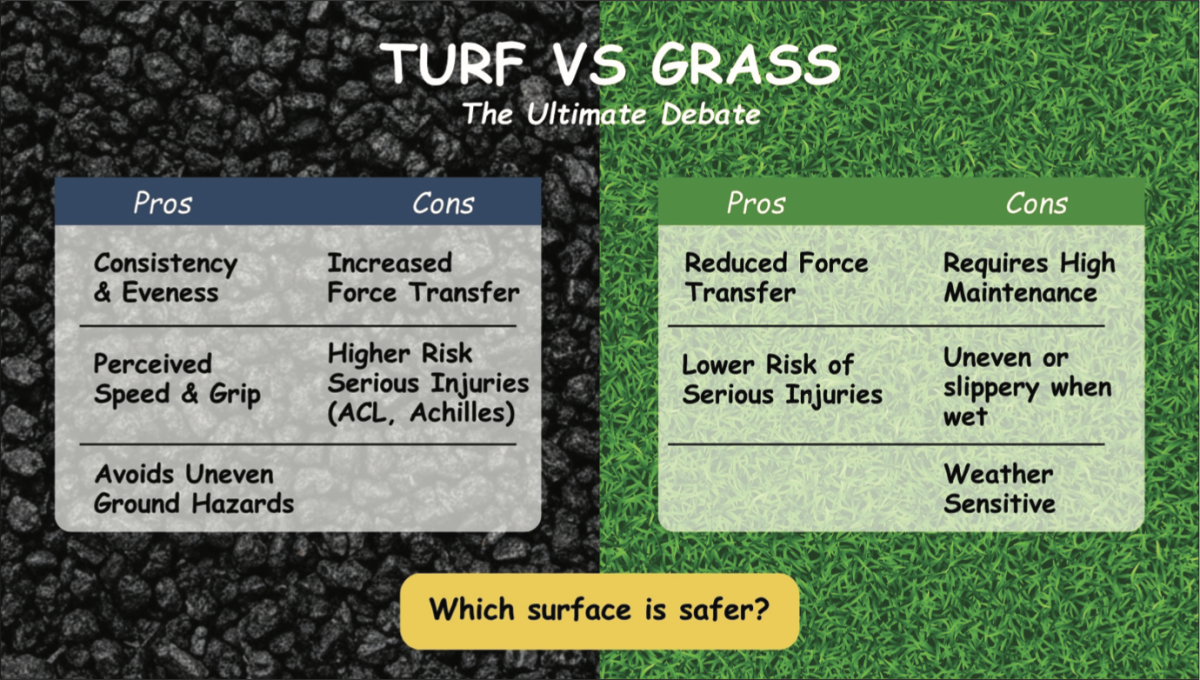
Infographic by Heli Shah
Turf has changed the game of football, soccer and baseball because the speed, consistency and durability it offers make it clear: turf not only makes the playing surface better, it is the future of sports.
One benefit of synthetic turf is that it is very easy to maintain because there is no need to water it, according to a 2025 Bella Turf Article.
A lot of people argue that turf increases injury risk, especially for knees and ankles.
That used to be true – for older, harder surfaces. But modern turf has improved dramatically.
One way that turf has improved dramatically is that cork infills are being used instead of rubber, according to a 2024 ProGreen article
There is not enough evidence to prove whether or not turf alone causes more non-contact injuries than natural grass, according to a Jan 30, 2024, Mass General article.
As a coach, I feel like walking out onto a turf field before the game feels more professional because the lines pop and the surface looks pristine, no matter the weather.
I also understand that my players enjoy playing on turf because they can make sharper cuts, and they say that the ball moves quickly and they can move quicker.
Turf gives an edge to players who rely on speed and precision.
Grass provides players with a softer surface to land on and it is the surface that many players, including myself, grew up playing on.
Playing on turf is better because it is more predictable, as it is man-made, according to a 2025 Grand Slam Safety article.
What makes turf so predictable is that because after a rainstorm, the field is less susceptible to rain, according to the MightyGrass article.
At the high school, I coach at all of our outdoor athletic facilities that have synthetic turf.
One of the nice benefits of the turf fields at the school I work at is that it does not get hot because it has cork infill rather than rubber infill that absorbs the heat.
Another reason why turf is more beneficial for sports is that there is hardly any maintenance that needs to be done on it.
Turf doesn’t need mowing, watering, or repainting lines every week.
After I have spent years practicing or playing on uneven grass, stepping onto turf feels like I am going from a dirt road to a racetrack.
The consistency of turf is another reason why I like it. I feel like every inch of the field plays the same.
There are no uneven patches, no muddy puddles, no surprise dips that twist your ankle when you cut.
Another benefit of turf is that it is more weather-resistant because players don’t have to worry about practices and games being canceled because of the rain.
From my experience, I found that natural grass causes a safety hazard because there were a handful of times when my team had to start practices late.
After all, we had to scare geese off the field.
Turf stays clean, playable and safe even after back-to-back events.
That also means more playing time for everyone – practices, games, tournaments and even community events can stack up without worrying about destroying the field.
This is something that grass can’t do.
At the end of the day, choosing between grass and turf really depends on what you value as a player, but for me, turf takes the win every time.
It’s consistent, fast, and always ready to go – no matter the weather or time of day.
As sports continue to evolve, it only makes sense that the fields we play on do, too.